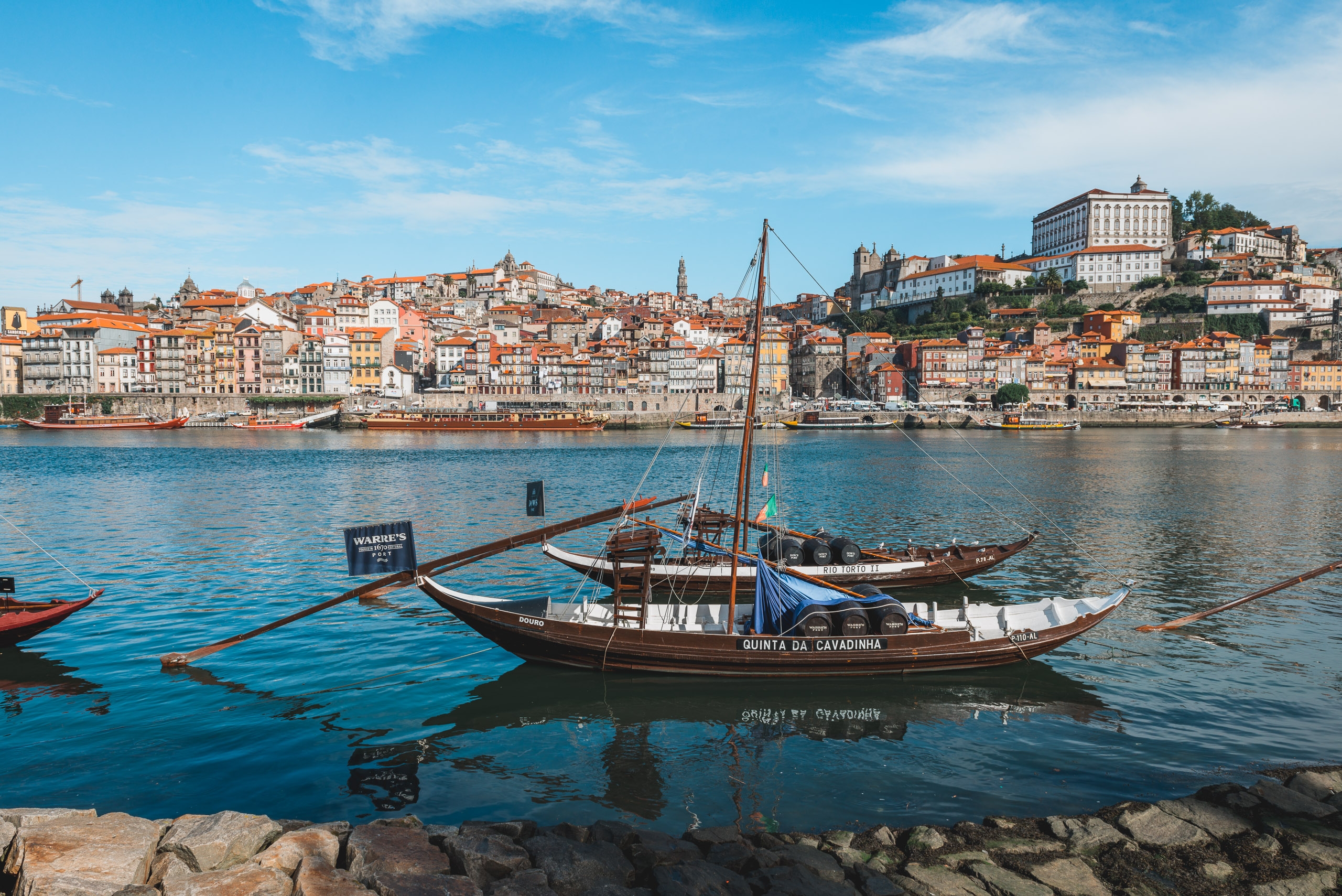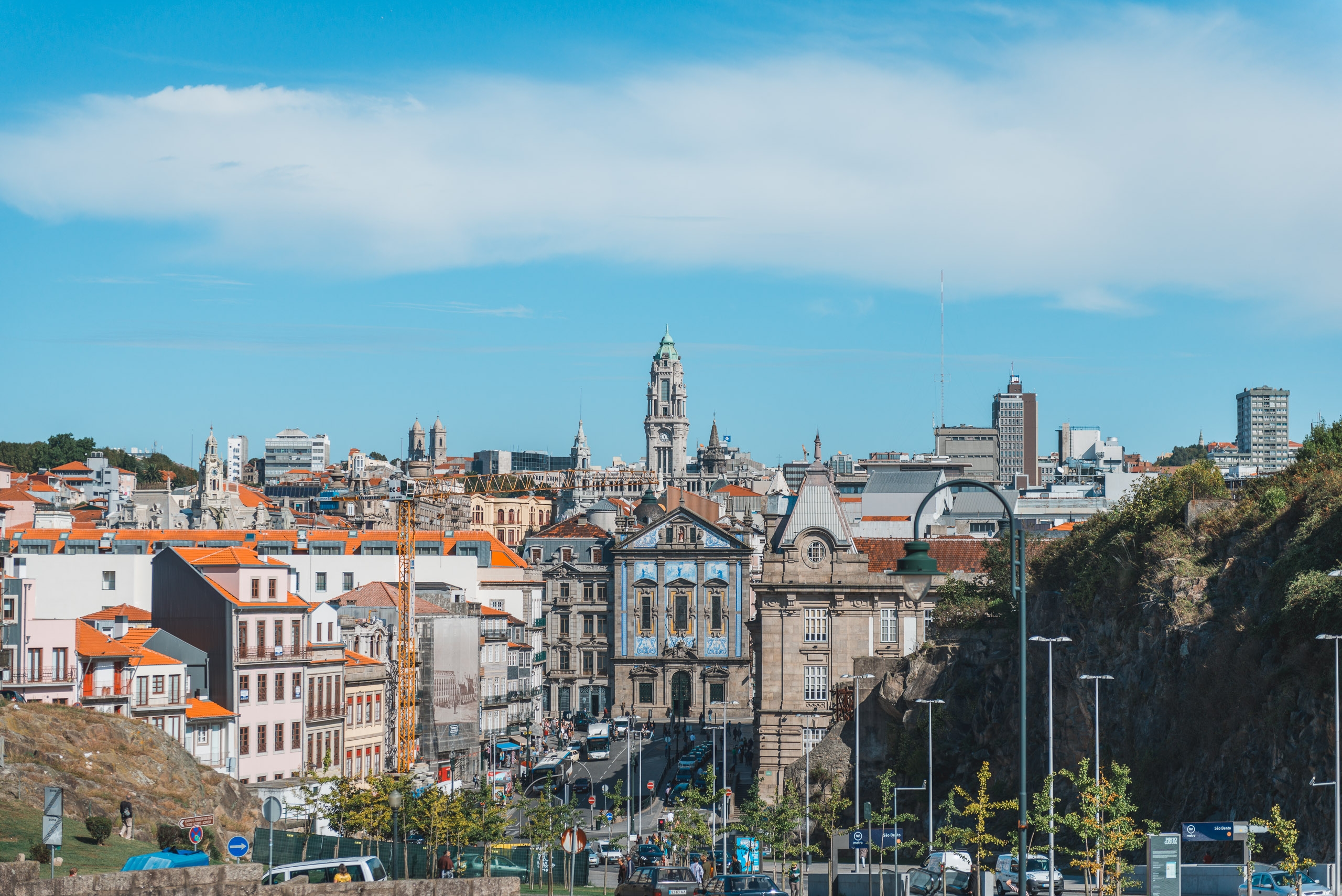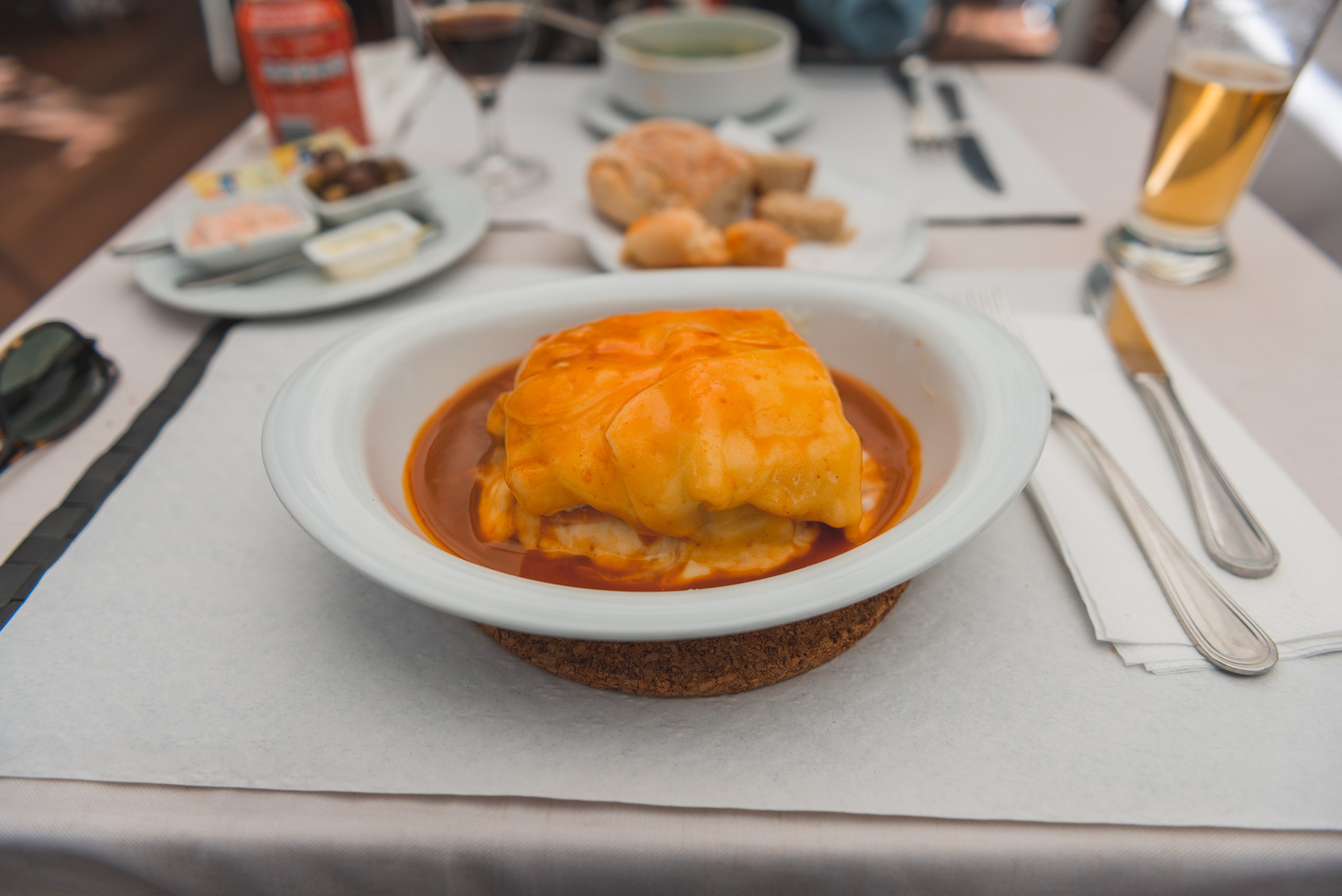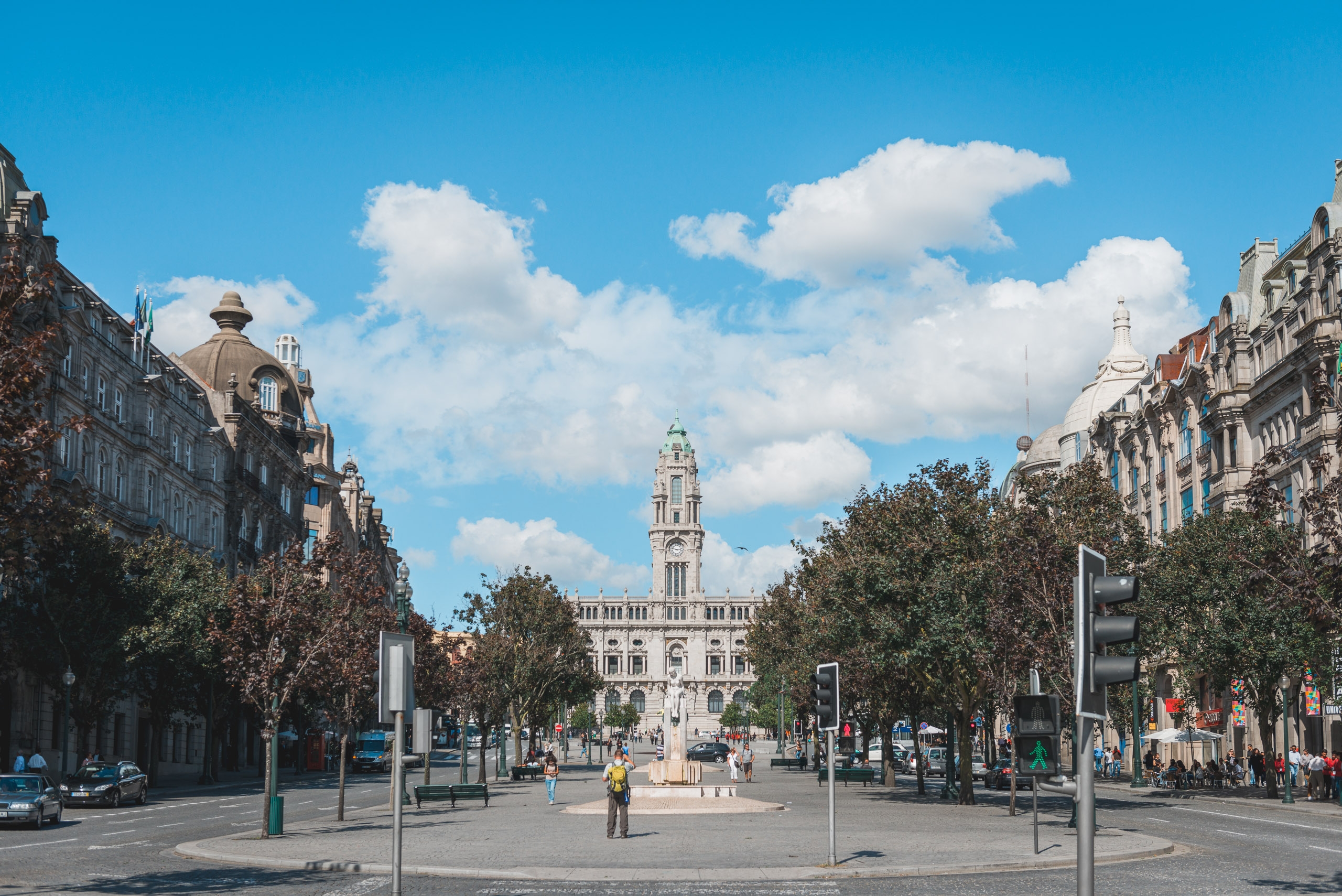Visit to Portugal: Two Days in Porto
October 18, 2012
The third stop on our tour of Portugal was a short visit to Portugal's second-largest city, Porto. Porto sits at the end of the Douro River on Portugal's north-central Atlantic coast, and is the hub of Portugal's wine industry. The city is divided by the Douro River, with Porto on the north side, and Vila Nova de Gaia on the south side. Vila Nova de Guia is the home to the numerous port houses, also called port lodges, where historically all of Portugal's port was made. Today many of the buildings remain, but are slowly being converted into tasting rooms and Port-centric visitor attractions, with the actual production of port wine happening elsewhere. In the photo below, the orange-roofed buildings in the foreground are all the port houses of Vial Nova De Gaia, with the city of Porto visible across the river.

A panorama of the Porto cityscape from our hotel.
After two days in the Douro Valley, we drove back to Porto on Wednesday following a leisurely breakfast, a boat tour of the river and an uneventful drive back into town. We dropped off the rental car at the Campanha rail station and took a taxi to our hotel, the Yeatman. The Yeatman is a newer hotel located in Vila Nova de Gaia, and popular for its proximity to the port houses and terrific views of Porto. Built into the hillside above the port district, all the rooms have river-facing patios and postcard-worthy views of the cityscape below.
The Yeatman hotel has a very robust wine program designed to promote Portuguese wine, and accordingly, Portuguese wine tourism. They have partnerships with over 80 quintas across Portugal, and have a vast library of wines available for tasting and wine education. Upon arrival, we scheduled a tour of the hotel's vast wine cellar and were treated to a terrific overview of Portuguese wines by region, varietal and style. The hotel's Wine Director tastes every batch of every wine offered at the hotel, an enviable position. Assuming she's not drunk all the time, she edits the extensive wine list for the hotel, and its Michelin-starred restaurant, also called the Yeatman. To be candid, we didn't know much about the hotel's wine reputation when we booked it; we had only read that it was a nice and new hotel with great views. After staying there, we highly recommend this hotel for the reasons mentioned, but also for its terrific overview of Portuguese wines and the local wine industry. If I had to do it over again, it might be better to start our wine tour in Porto to get grounded and educated then move into the Douro Valley.

Jessica shoots an iPhone panorama of Porto.

Jessica's iPhone panorama taken from the patio of our hotel room.
We arrived at the hotel around 3PM and went straight to the balcony to take photos as the sun was shining brightly and the view truly is spectacular. We booked a tour of the hotel's wine cellar at 5PM, and decided to have dinner at the hotel's well-regarded restaurant that evening. Due to our last-minute booking, dinner was at 7:30, which is right as the restaurant opens. Awkwardly, we were the only ones present when we were seated, but by the time we left around 10:30PM, the place was packed. Dinner in Portugal, like much of Europe, is a late affair. Most businesses close during the day from 1-3PM for a long lunch, a bottle of wine and a nap, so naturally this pushes out the rest of the evening accordingly. Living in New York, we typically eat dinner between 8 and 9, so a 7:30 reservation felt like the early-bird special (I could find no such special noted on our tab).
Our plan for the next day was to tour the city of Porto from the morning to early afternoon, then visit the port houses after lunch. Fortunately the weather was nearly perfect, and after a leisurely breakfast, we headed out for our Frommer's walking tour with camera, guide book and iPhone in-hand.
Most of the port houses don't open until late morning, so we walked down the quiet and sleepy streets of Vila Nova de Gaia toward to cross the Douro River along the pedestrian pathway at the bottom of the Dom Luis I Bridge. The Douro waterfront has been greatly revitalized in the past 10 years with the surge in wine-related tourism. My take is the improvements have been tastefully done, with an appealing variety of restaurants, cafes and wine bars lining the picturesque waterfront.

Boats along the Douro River waterfront in Vila Nova de Gaia
The port companies have paid a huge role in revitalizing this part of town and establishing its tourist industry, and a monument (of sorts) to their contributions is along the waterfront with signs noting the significant local port brands. Here I'm standing next to the Taylor's sign, which we would visit later. Taylor's is one of the major export brands you can easily find in the US, along with Sandeman and Fonseca.

Me on the Port Walk waterfront in Vila Nova de Gaia
Our passage to the Porto side was via the Ponte Dom Luis I bridge pictured below. There are a number of significant bridges in Porto, each of which are remarkable and photogenic in their own right. The Dom Luis bridge was built by a student and collaborator of Gustav Eiffel, based on one of Eiffel's designs for a rail bridge that exists just down the river. Before he rose to fame with the Eiffel Tower and other significant iron works, one of Eiffel's earliest commissions was the Porto rail bridge. The project was intensely scrutinized as local authorities were concerned the young and unproven engineer might not finish his work on time or on budget. He did, and of course, the rest is history.

Beneath the Ponte Dom Luis I Bridge between Vila Nova de Gaia and Porto
Once across the bridge, Porto was much like Lisbon: lots of hills, stairs and steep cobblestone streets. Energized by our two days' rest, we hiked up among the historic neighborhoods that line the northern part of the river, to the hilltop cathedral known as the Se. From there, the views over the rest of Porto were quite impressive. We walked across Porto toward Liberdade Square and the terminus of our walking tour, Porto's historic rail station.

Overlooking Porto

Overlooking Porto

Jessica doing some research during our walking tour of Porto

Pedestrian-friendly road construction signs

"The Perfect Love"
We started to get hungry around 1PM, and although the local varieties of Pringles were unique and tasty, we decided to find a local cafe for a real lunch.

A brief stop for a 1-Euro snack from the Pringles Machine
There are a few "national dishes" of Portugal that we had tried already. These include roasted chicken piri-piri, which is superbly roasted rotisserie chicken with a spicy chili sauce, cod, a staple of the Portuguese diet, prepared in almost any manner (we had roast cod with a tomato and basil puree at Quinta Romaneira), and lots of shellfish. Still on our list was caldo verde, a popular appetizer on almost every menu. Its a simple soup, often with a chicken-based broth, kale, onions, carrots and potatoes, typically served with bread for dipping. Caldo Verde is the Portuguese-equivalent of wedding soup, and is served at almost every meal of importance, and as an appetizer at lunch and dinner.

Jessica eats one of the national dishes of Portugal, Caldo Verde (green soup)
One of the more interesting dishes I discovered was the "National Sandwich of Porto", the Francesinha. (I'm not sure how a city can have a national sandwich, but bear with me). The Francesinha is a local adaptation of the French croque-monsieur, but much improved in my opinion. The sandwich is made from thick-cut bread and includes ham, a split and fried sausage, a piece of grilled steak and sometimes grilled chicken. The sandwich is wrapped in mozzarella cheese and baked into a gooey, toasty brick which is covered in a house-secret, beer-based sauce of tomatoes, lobster and prawns. This may sound incredible, and indeed it is. I had this for lunch, and as an appetizer that night at one of Porto's top-rated restaurants, DOP. Start googling it now and find one in your area.

Behold! The traditional sandwich of Porto, the Francesinha (little Frenchie)
After our lunch, we continued our tour on foot and did a bit of souvenir shopping in the area. Like Lisbon, Porto is also known for its ceramics and we were eager to find something notable to bring back from our trip.

Liberdade Square
We also had on our itinerary a visit to a well-known local bookstore called Livraria Lello. Aside from its indie selection of interesting books, the store is an architectural landmark known for its exquisite woodwork and hand-carved stair case. Tourists and locals alike refer to this store as the Harry Potter bookshop, as its interior is reminiscent of the Hogwart's School of Witchcraft. The bookshop is a Mecca for Harry Potter fans, but for very legitimate reasons. Before she was a billionaire author, JK Rowling lived in Porto and taught English at the local university. It was at the Livraria Lello bookstore that she started writing Harry Potter and the Philosopher's Stone, and as I've said earlier, the rest is history.

The Livraria Lello Bookstore
Note: The bookstore does not permit photography inside the store, but you can see photos of its interior here.
The costumes in the Harry Potter novels and movies are based on clothing worn by students at Porto's university. Students wear blazers, oxford shirts, rep ties and wool capes, which should look familiar to fans of the books and movies.

University Students outside the Se, the Cathedral of Porto
After the visit to the bookstore, we made our way back across the river to visit a few port houses for port tasting. Most of the larger port houses bundle a tour with the tasting, so you typically have to adjust your schedule to that of the tour guides in order to visit. We were running short on time, and weren't really interested in the tour so we skipped some of the larger, better-known port houses for those highly recommended by Frommer's. The first we visited was Ramos Pinto, which was, in my opinion, the best port we had in Portugal. We bought one bottle to bring back, but US Customs is finicky and our hotel advised we should not try to bring more than two bottles per person. They also delighted in telling us that they don't ship to the US, because basically US liquor laws are a total pain in the ass. "Thanks for the feedback, we'll pass that along."

Jessica port tasting at Ramos Pinto

Port tasting at Ramos Pinto
Our second stop was at Taylor's, which is among the largest and best-known port brands. We skipped the tour and headed straight for the tasting. I would give Ramos Pinto a slight edge, but the Taylor's tasting room and restaurant were easily the most beautiful.

Port tasting at Taylor's
We headed back to the hotel to relax a bit before dinner that night at DOP. We thought we had asked for a more Portugal-appropriate reservation time of 8:30, but of course we were the first ones there. DOP was one of the best meals we had in Portugal, and the kitchen is led by a warm and charismatic chef named Rui Paula. He stopped by to say hello, and seemed amused by the hapless pair of American diners. After dinner, he insisted on us trying a sample of canapés paired with Portuguese wines. We relented. We had a remarkable fois gras-stuffed cherry paired with ruby port. If you're ever in Portugal, please pay a visit to DOP; you will not regret it.
We returned to the hotel late that night and began packing for our departure the next morning. We had dampened our ambition for the next day's agenda, and decided to sleep late, catch the train back to Lisbon, taxi over to Cascais, and spend the afternoon lounging around the pool.
Porto is definitely a city in transition. In the past 10 years, significant public investment has been made in revitalizing the waterfront on both sides of the River, and the downtown, plazas, bars and restaurants were a hive of activity. I wish we had more time to explore the city; personally, I liked it better than Lisbon and really connected to the vibe and culture. Porto is the unofficial wine capital of Portugal, and that alone makes it a must-see stop on any visit to the country. We've already vowed to return, and Porto will surely be on the itinerary.

The Porto Cityscape at Night
WHERE WE STAYED
The Yeatman Hotel: A wine-centric hotel with the best views in the city: The Yeatman Hotel
WHERE WE DINED
Gastronomic Restaurant: Michelin-starred Portugese fine dining (in the Yeatman hotel): The Gastronomic Restaurant (formerly called The Yeatman)
Armazém do Caffè: Quick stop for coffee and wifi: Listing on Foursquare
Avenida Café e Restaurante: traditional outdoor cafe & Portuguese food: Listing on Foursquare
Port Tasting at Ramos Pinto: Our favorite of the Ports we tried: Ramos Pinto
Port Tasting at Taylor's: The most popular Lodge in a beautiful setting: Taylor's
DOP: One of the best meals in Portugal from Michelin-starred chef Rui Paula: DOP by Rui Paula